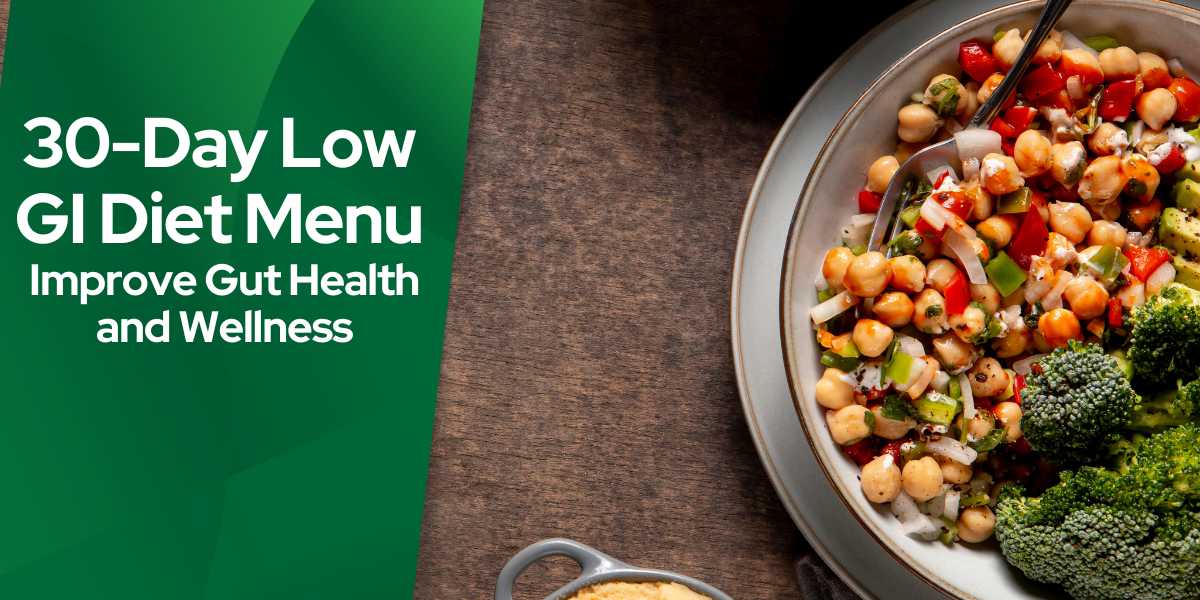30-Day Low GI Diet Menu: Improve Gut Health and Wellness
Embarking on a 30-day low glycemic diet can be your gateway to enhancing your overall wellness by stabilizing blood sugar, reducing inflammation, and supporting healthy gut bacteria.
What is a Low Glycemic Diet?
A low glycemic diet mainly consists of foods that don’t sharply spike your blood sugar levels. The Glycemic Index (GI) measures how quickly a food increases blood sugar, with low GI foods offering a slow and steady release of energy.
Unlike high GI foods, low GI foods promote longer satiety, keeping energy levels balanced throughout the day. This diet emphasizes consuming whole foods over processed foods, thereby aiding in better blood sugar management and reducing risks associated with high blood glucose levels.
The Health Benefits of a Low GI Diet
Adopting a low glycemic diet confers numerous health benefits beyond just maintaining stable sugar levels. It includes weight management, improved cholesterol levels, and can even impact fertility positively. This diet is especially helpful for individuals looking to manage diabetes or those predisposed to the condition.
- Weight Management: Helps in losing weight efficiently by promoting fat loss.
- Improved Digestion: Encourages better gut health by fostering beneficial gut bacteria.
- Reduced Inflammation: Minimizes inflammatory responses in the body which can lead to conditions like joint pain.
- Enhanced Mood: Reduces energy crashes, leading to improved focus and mood.
Structure of a 30-Day Low Glycemic Diet Menu
Crafting a balanced 30-day menu doesn’t have to be daunting. The key elements involve a mix of low GI foods, containing ample fiber, proteins, and healthy fats. Incorporate a variety of delicious meals to keep the diet engaging.
Breakfast Options
Mornings can start with a hearty dish to fuel the day. Consider meals like:
- Veggie Omelet: Packed with spinach, tomatoes, and bell peppers, this dish keeps the GI level low while providing high protein and fiber.
- Greek Yogurt with Berries: A combination of probiotic-rich yogurt and antioxidant-packed berries.
- Low GI Cereal: Whole grain cereals combined with nuts and seeds can offer a great start to your day.
Lunch Ideas
Your lunch menu can be exciting and nutritious. These options offer variety and richness in essential nutrients:
- Grilled Chicken Salad: Incorporate a mix of greens, avocados, and nuts to make it a filling low GI meal.
- Lentil Soup: High in fiber and protein, lentils make for a satisfying, low GI lunch.
- Wholegrain Wraps: Fill with turkey, hummus, and plenty of crispy vegetables.
Dinner Selections
For dinner, focus on whole foods and balanced nutrients:
- Quinoa Stir-Fry: Made with seasonal vegetables and a hint of lemon and herbs.
- Baked Salmon: Rich in healthy omega-3 fats, this can be paired with roasted veggies.
- Stuffed Bell Peppers: These can be packed with beans, rice, and spices for a delicious and filling meal.
Snack Suggestions
Snacking is crucial for maintaining energy levels. Here are some ideal low GI snack options:
- Mixed Nuts: Almonds and walnuts can curb hunger between meals.
- Hummus with Veggies: Carrot and cucumber sticks paired with hummus are both tasty and healthy.
- Fruit Slices: Apples and pears, eaten with skins, as they are low GI.
Things to Keep in Mind on a Low GI Diet
While the focus is on low GI foods, it’s important to understand that variability is essential in any healthy diet. Clients have frequently mentioned feeling more energized and noticing improvements in skin conditions and digestion after switching to a low GI regime. However, always consult a dietitian to adapt the diet accordingly to personal health needs.
Common Myths About Low GI Diets
Misunderstandings about low glycemic diets abound. It’s vital to bust some myths:
- Low GI Foods Are Low-Calorie: This is not always the case. Portion control remains important.
- No Sweets Allowed: You can enjoy sweet treats in moderation, but they should be from low GI sources like dark chocolate.
- You Can’t Eat Out: Many restaurants offer low GI options; it’s just a matter of making informed choices.
Embracing a Healthier Lifestyle
The journey with a low glycemic diet is more than a mere eating style—it encourages a holistic lifestyle shift. With dedication and a few tweaks in meal planning, the benefits can be substantial, promoting long-term health and well-being.
Whether your goal is to lose weight, manage blood sugar levels, or simply lead a healthier life, embracing a low GI diet can place you on a rewarding trajectory for better health.
| Food Category | Examples |
|---|---|
| Grains | Quinoa, barley, oats |
| Fruits | Apples, berries, cherries |
| Vegetables | Spinach, broccoli, carrots |
| Proteins | Chicken, tofu, salmon |
Stepping through the doorway to a low glycemic lifestyle not only supports gut and metabolic health but also introduces an enjoyable variety to your meals. The 30-day menu is a step worth savoring, one delicious meal at a time!


